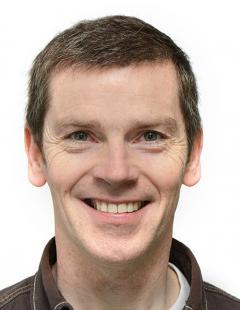Dr Gerry McLachlan on cystic fibrosis
Choosing the best model to evaluate gene therapy strategies for cystic fibrosis in humans and his dream of being Kenny Dalglish.

Dr Gerry McLachlan is a group leader at The Roslin Institute working as part of a large consortium to develop gene therapy for cystic fibrosis – an inherited condition caused by mutations in a gene. People affected by the condition are more prone to lung diseases and have a significantly reduced life expectancy. In this interview with Science Communication Intern Maggie Szymanska, he speaks about his work.
Could you tell me about your work in a nutshell?
I work as part of the UK Cystic Fibrosis Gene Therapy Consortium and, as the name suggests, we’re trying to develop gene therapy for cystic fibrosis. The Consortium has been running for almost 20 years now. It is a collaboration between the University of Edinburgh, the University of Oxford and Imperial College London.
Within the Consortium, our team at Roslin is using sheep as a model to study gene delivery to the lung in people. We have been involved in a lot of preclinical testing of gene therapy vectors, which we then try to develop and optimise. Over the years, our gene therapy vectors have even gone as far as clinical trials in cystic fibrosis patients with some success.
How do you see the future of your research?
I’m quite excited, I have to say! In the past few years, we’ve been looking at using a new viral-based vector, giving us a very optimistic view for the future. This viral based vector, an SIV vector which can cause disease in primates, is similar to HIV. It is essentially the same kind of virus therefore it has to be modified to prevent it from being harmful.
We have been working on these viral-based methods for a while and it seems that they are more efficient than the non-viral systems used previously. The advantage of the viral mechanism is that SIV integrates into the genome of patients receiving treatment. Using the non-viral system, in a big multi-dose clinical trial we did for twelve months, the lung function of patients who got the placebo declined by about 4% over the course of that time period. However, the lung function patients who got the gene therapy was stable. The non-viral methods had an effect, but we’re hoping that the virus that we’re developing will be more efficient and have a more long-lasting effect.
We’re quite optimistic and we’ve got funding in place from the Wellcome Trust and the Department of Health through the Health Innovations Challenge Fund that allows us to do clinical trial. And we’ve recently partnered up with a pharmaceutical company, which allows us to do a much more comprehensive program and get to clinic quicker. We really are quite optimistic for the future as this partnership may really provide us with a lot more resources, which we really need to be able to make this a viable treatment for patients.
Could you tell me about a challenge you’ve experienced?
There are so many challenges! For instance, it is very difficult to know what the best model to use is i.e. the animal species we can use to develop our therapies in humans. In the early years we did a lot of studies on mice and then went straight to the clinic but that translation was just too much of a jump. The mouse studies just weren’t predictive enough because mice are very different from humans. We had the feeling that we needed another model to help bridge the gap from preclinical work to clinical.
That’s when we started doing some more work on sheep, which is a more relevant model. The lung size, structure, physiology and immune responses of sheep are much more similar to humans than that of mice.
However, developing a sheep model also brought challenges. It is estimated that the whole surface area of a human lung is the size of half of a tennis court… So, it’s a challenge to afford enough material for studies in a large animal model.
I’ve heard you took part in public engagement activities at the Easter Bush Science Outreach Centre. What did you enjoy about those?
I like interacting with people and I’m also very passionate about science. As I enjoy science, I like to encourage others. I actually do a bit of public engagement outside the Institute as well, such as giving talks to schools or attending a two-day primary school science event that happens every year in Peebles. I really enjoy those kinds of activities. While I was gaining experience in public engagement, I realised that communication is key and you have to be able to speak in such a way that others will understand.
If you weren’t a scientist, what would you be?
My dream growing up was to be a professional footballer. I wanted to be Kenny Dalglish who was my idol at the time! Sadly I wasn’t anywhere near as good. I also really liked technical drawing subjects at school, so architecture might have been something I would have considered if I hadn’t decided on science.
Why did you decide to become a scientist?
I loved science in school, it was always my favourite subject! I especially enjoyed chemistry and biology, so I decided to do a degree in biochemistry and have stayed in science since then. I was really lucky because my first chemistry teacher was a very inspiring and charismatic man who taught the subject really well. He taught me for a couple of years and definitely encouraged my love for the subject. These kind of early influences definitely make a large difference.
Related links
Partnership boosts cystic fibrosis therapy bid


